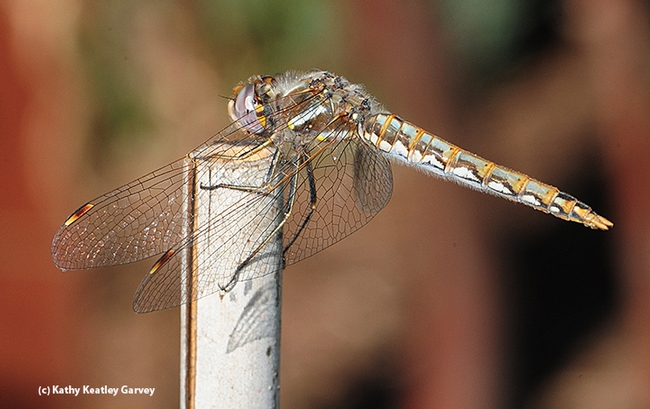Dragonflies are fierce predators but they are predator-shy.
"If it looks like a duck, swims like a duck, and quacks like a duck, then it probably is a duck," as the saying goes. If you look like a predator, walk or fly like a predator and act like a predator, that dragonfly perched near you will take off.
The other day a variegated meadowhawk dragonfly, landed on a bamboo stake in our yard. It was identified as a "mature female Sympetrum corruptum" by dragonfly expert Rosser Garrison, a senior insect biosystematist in the California Department of Food and Agriculture's Plant Pest Diagnostics Branch, Sacramento, and by naturalist Greg Kareofelas, an associate at the Bohart Museum of Entomology, University of California, Davis.
How do you "catch" a dragonfly, that is, get close enough to photograph it? It helps to have a professional camera, fast shutter and a long lens, like a 200mm. Sometimes you can photograph them with a 105mm lens. To get this photo, I pretended to be part of a butterfly bush. I left my tripod behind and edged slowly, closer and closer, camera poised at the ready (a sudden movement and the dragonfly will be in the next zip code), focused, and clicked. A stiff breeze draped her wings over her head as if she were playing hide 'n seek.
Oftentimes, I'll sit in a chair and wait for them to return to the perch. They often do.
You can also drop to the ground (make yourself look little and uninterested.)
"Just as the sun was setting last night, I noticed many dragonflies flying in my backyard," Kareofelas said. "They were flying very quickly and very high, but every so often one would swoop down and land. When they do, you can approach slowly and get close. When you approach a perched dragonfly, slowly stoop as you get closer. Many times, if you do not appear larger as you get closer, the dragonfly does not realize you are getting close."
Good advice.
The variegated meadowhawk is one of the dragonflies on a Bohart Museum of Entomology poster, the work of entomologist Fran Keller and Kareofelas.
Its habitat ranges from throughout much of the United States to British Columbia and Canada. It's found as far south as Honduras, and as far west as eastern Asia.
It hangs around ponds, lakes and swamps to catch its prey. if you don't look, move or act like prey, you, too, can "catch" a dragonfly.
With your camera...
Attached Images:
